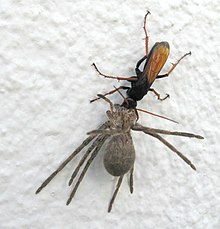
Bees are winged insects closely related to wasps and ants, known for their roles in pollination and, in the case of the best-known bee species, the western honey bee, for producing honey. Bees are a monophyletic lineage within the superfamily Apoidea. They are currently considered a clade, called Anthophila. There are over 20,000 known species of bees in seven recognized biological families. Some species – including honey bees, bumblebees, and stingless bees – live socially in colonies while most species (>90%) – including mason bees, carpenter bees, leafcutter bees, and sweat bees – are solitary.

The superfamily Apoidea is a major group within the Hymenoptera, which includes two traditionally recognized lineages, the "sphecoid" wasps, and the bees. Molecular phylogeny demonstrates that the bees arose from within the traditional "Crabronidae", so that grouping is paraphyletic, and this has led to a reclassification to produce monophyletic families.

Sawflies are wasp-like insects that are in the suborder Symphyta within the order Hymenoptera, alongside ants, bees, and wasps. The common name comes from the saw-like appearance of the ovipositor, which the females use to cut into the plants where they lay their eggs. The name is associated especially with the Tenthredinoidea, by far the largest superfamily in the suborder, with about 7,000 known species; in the entire suborder, there are 8,000 described species in more than 800 genera. Symphyta is paraphyletic, consisting of several basal groups within the order Hymenoptera, each one rooted inside the previous group, ending with the Apocrita which are not sawflies.

Apocrita is a suborder of insects in the order Hymenoptera. It includes wasps, bees, and ants, and consists of many families. It contains the most advanced hymenopterans and is distinguished from Symphyta by the narrow "waist" (petiole) formed between the first two segments of the actual abdomen; the first abdominal segment is fused to the thorax, and is called the propodeum. Therefore, it is general practice, when discussing the body of an apocritan in a technical sense, to refer to the mesosoma and metasoma rather than the "thorax" and "abdomen", respectively. The evolution of a constricted waist was an important adaption for the parasitoid lifestyle of the ancestral apocritan, allowing more maneuverability of the female's ovipositor. The ovipositor either extends freely or is retracted, and may be developed into a stinger for both defense and paralyzing prey. Larvae are legless and blind, and either feed inside a host or in a nest cell provisioned by their mothers.

The superfamily Ichneumonoidea contains one extinct and three extant families, including the two largest families within Hymenoptera: Ichneumonidae and Braconidae. The group is thought to contain as many as 100,000 species, many of which have not yet been described. Like other parasitoid wasps, they were long placed in the "Parasitica", variously considered as an infraorder or an unranked clade, now known to be paraphyletic.
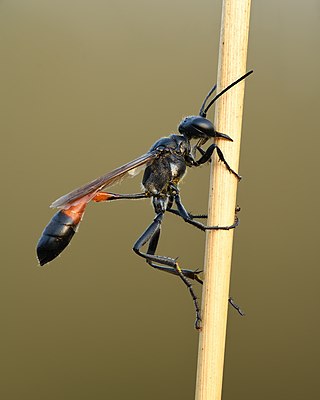
The Sphecidae are a cosmopolitan family of wasps of the suborder Apocrita that includes sand wasps, mud daubers, and other thread-waisted wasps.

The Tiphiidae are a family of large, solitary wasps whose larvae are parasitoids of various beetle larvae, especially those in the superfamily Scarabaeoidea. Until recently, this family contained several additional subfamilies, but multiple studies have independently confirmed that these comprise a separate lineage, and are now classified in the family Thynnidae.

Alexandr Pavlovich Rasnitsyn is a Russian entomologist, expert in palaeoentomology, and Honored Scientist of the Russian Federation (2001). His scientific interests are centered on the palaeontology, phylogeny, and taxonomy of hymenopteran insects and insects in general. He has also studied broader biological problems such as evolutionary theory, the principles of phylogenetics, taxonomy, nomenclature, and palaeoecology. He has published over 300 articles and books in several languages. In August 2008 he was awarded the Distinguished Research Medal of the International Society of Hymenopterists.

Parasitoid wasps are a large group of hymenopteran superfamilies, with all but the wood wasps (Orussoidea) being in the wasp-waisted Apocrita. As parasitoids, they lay their eggs on or in the bodies of other arthropods, sooner or later causing the death of these hosts. Different species specialise in hosts from different insect orders, most often Lepidoptera, though some select beetles, flies, or bugs; the spider wasps (Pompilidae) exclusively attack spiders.

The superfamily Chrysidoidea is a very large cosmopolitan group, all of which are parasitoids or cleptoparasites of other insects. There are three large, common families and four small, rare families. Most species are small, almost never exceeding 15 mm. This superfamily is traditionally considered to be the basal taxon within the Aculeata, and, as such, some species can sting, though the venom is harmless to humans.

Bembix rostrata is a species of sand wasp native to Central Europe. The genus Bembix - of which B. rostrata is among the most distinctive species - has over 340 species worldwide and is found mostly in warm regions with open, sandy soils; Australia and Africa have a particularly rich variety of species.
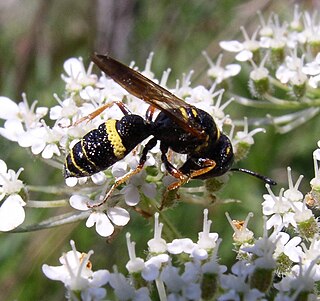
Philanthus gibbosus, the hump-backed beewolf, is a species of bee-hunting wasp and is the most common and widespread member of the genus in North America. P. gibbosus is of the order Hymenoptera and the genus Philanthus. It is native to the Midwestern United States and the western Appalachians. P. gibbosus are often observed to visit flowers and other plants in search of insect prey to feed their young. The prey that P. gibbosus catches is then coated in a layer of pollen and fed to the young wasps.

A wasp is any insect of the narrow-waisted suborder Apocrita of the order Hymenoptera which is neither a bee nor an ant; this excludes the broad-waisted sawflies (Symphyta), which look somewhat like wasps, but are in a separate suborder. The wasps do not constitute a clade, a complete natural group with a single ancestor, as bees and ants are deeply nested within the wasps, having evolved from wasp ancestors. Wasps that are members of the clade Aculeata can sting their prey.

The subfamily Pemphredoninae also known as the aphid wasps, is a large group in the wasp family Crabronidae, with over 1000 species. Historically, this subfamily has frequently been accorded family status. In some recent phylogenetic analyses, one of the subtribes within this group is the sister lineage to the superfamily Apoidea, and accorded family rank as Ammoplanidae along with Pemphredonidae and Psenidae so as to keep families monophyletic.
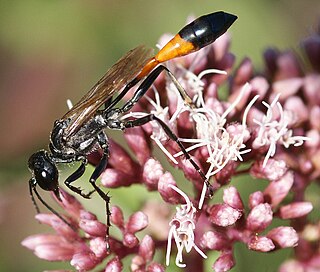
Ammophila sabulosa, the red-banded sand wasp, is a species of the subfamily Ammophilinae of the solitary hunting wasp family Sphecidae, also called digger wasps. Found across Eurasia, the parasitoid wasp is notable for the mass provisioning behaviour of the females, hunting caterpillars mainly on sunny days, paralysing them with a sting, and burying them in a burrow with a single egg. The species is also remarkable for the extent to which females parasitise their own species, either stealing prey from nests of other females to provision their own nests, or in brood parasitism, removing the other female's egg and laying one of her own instead.
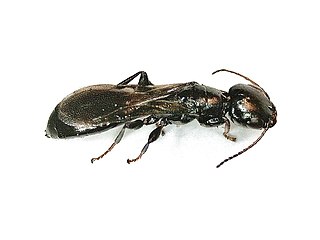
The Bethylidae are a family of aculeate wasps in the superfamily Chrysidoidea. As a family, their biology ranges between parasitoid wasps and hunting wasps.

Ammophila urnaria is a species of hunting wasp in the family Sphecidae. It is a black and red insect native to the eastern United States. It feeds on nectar but catches and paralyses caterpillars to leave in underground chambers for its developing larvae to consume.

The Thynnidae are a family of large, solitary wasps whose larvae are almost universally parasitoids of various beetle larvae, especially those in the superfamily Scarabaeoidea. Until recently, the constituents of this family were classified in the family Tiphiidae, but multiple studies have independently confirmed that thynnids are a separate lineage.

Pison spinolae, commonly known as mason wasp, is a solitary wasp of the family Crabronidae, found throughout New Zealand.
Jouault, Corentin; Rosse-Guillevic, Simon. "A new genus of praeaulacid wasp from the mid-Cretaceous Kachin amber (Myanmar)". Annales de Paléontologie. 109 (1): 102599. doi:10.1016/j.annpal.2023.102599.
